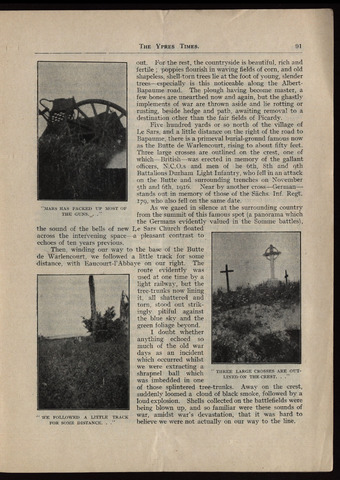The Ypres Times.
01
out. For the rest, the countryside is beautiful, rich and
fertile poppies flourish in waving fields of corn, and old
shapeless, shell-torn trees lie at the foot of young, slender
treesespecially is this noticeable along the Albert-
Bapaume road. The plough having become master, a
few bones are unearthed now and again, but the ghastly
implements of war are thrown aside and lie rotting or
rusting, beside hedge and path, awaiting removal to a
destination other than the fair fields of Picardv.
Five hundred yards or so north of the village of
Le Sars, and a little distance on the right of the road to
Bapaume, there is a primeval burial-ground famous now
^as the Butte de Warleneourt, rising to about fifty feet.
Three large crosses are outlined on the crest, one of
whichBritishwas erected in memory of the gallant
officers, N.C.O.s and men of he 6th, 8th and qth
Battalions Durham Light Infantry, who fell in an attack
on the Butte and surrounding trenches on November
5th and 6th, 1916. Near by another crossGerman
stands out in memory of those of the Sachs. Inf. Regt.
179, who also fell on the same date.
"mars has packed up most of As we gazed in silence at the surrounding country
the guns. from the summit of this famous spot (a panorama which
the Germans evidently valued in the Somme battles),
the sound of the bells of new Le Sars Church floated
across the intervening spacea pleasant contrast to
echoes of ten years previous.
Then, winding our way to the base of the Butte
de Warleneourt, we followed a little track for some
distance, with Eaucourt-l'Abbaye on our right. The
route evidently was
used at one time by a
light railway, but the
tree-trunks now lining
it, all shattered and
torn, stood out strik
ingly pitiful against
the blue sky and the
green foliage beyond.
I doubt whether
anything echoed so
much of the old war
days as an incident
which occurred whilst
we were extracting a
shrapnel ball which
was imbedded m one
of those splintered tree-trunks. Away on the crest,
suddenly loomed a cloud of black smoke, followed by a
loud explosion. Shells collected on the battlefields were
being blown up, and so familiar were these sounds of
we followed a little track war. amidst war's devastation, that it was hard to
for some distance. believe we were not actually on our way to the line.

